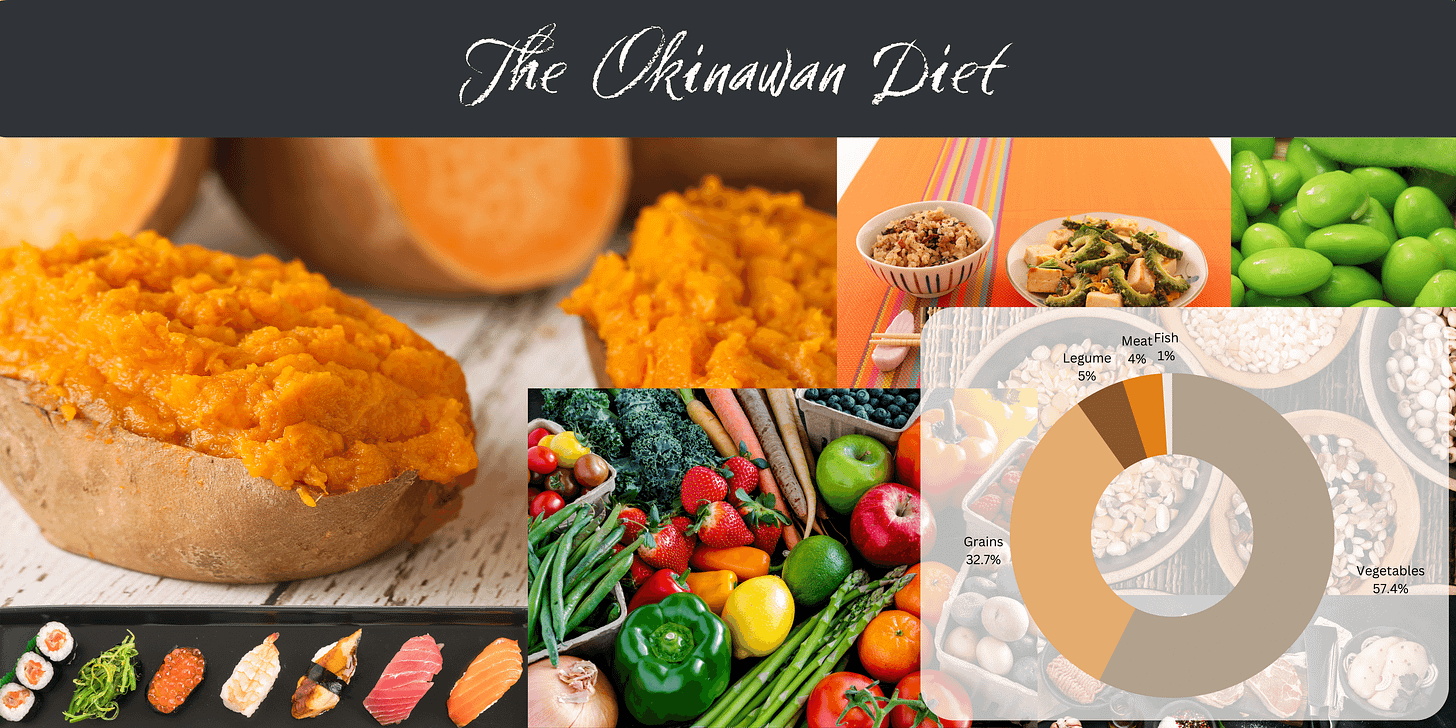Diet, Dietary Factors, and Ageing: A Comprehensive Exploration
The following article delves into the sophisticated interplay between diet restriction, meal patterns, the Mediterranean Diet, and the Okinawan diet that influence healthspan and lifespan.
The human pursuit of longevity has persisted throughout history, often intertwining with nutritional habits and dietary regimes. Although myriad variables influence the ageing process, diet plays a foundational role.
Diet Restriction and Calorie Intake
DR remains a central non-genetic strategy to extend lifespan and promote health. The conventional wisdom linking reduced calorie intake to extended lifespan has recently evolved. The timing and composition of food intake have been identified as crucial in modulating ageing pathways, shifting our understanding of DR beyond mere calorie counting.
Meal Frequency and Timing
The typical DR requires reduced calorie intake at every meal, without malnutrition. This pattern, however, may be challenging for long-term adherence. Recent discoveries in animal studies, particularly in mice, have revealed the complexity behind calorie restriction (CR). These studies showed that CR-induced metabolic benefits and lifespan extension were often coupled with prolonged daily fasting (at least 18 hours) after consuming meals within a short time frame.
Several fasting regimens, including Intermittent Fasting (IF), Periodic Fasting (PF), and Time-Restricted Feeding (TRF), have shown promising results in rodents. These methods, focusing on controlling the timing of food intake, offer a novel intervention to enhance healthy ageing.
Mediterranean Dietary Pattern
The Mediterranean Diet (MedDiet), prevalent in countries like Greece, Italy, and Spain during the 20th century, has drawn attention for its potential anti-ageing effects. Rich in vegetables, fruits, seafood, and healthy fats, the MedDiet limits red meat and processed foods.
Nutritional Richness and Health Benefits
This pattern offers a plethora of bioactive compounds, including vitamins, minerals, and unsaturated fatty acids. High adherence to the MedDiet has been linked to reduced age-related diseases such as cardiovascular issues, cancer, and neurodegenerative conditions. Furthermore, an increase in MedDiet adherence correlates with a significant reduction in overall mortality.
Impact on Nutrient Signalling and Mitochondrial Function
The MedDiet's low animal protein intake, abundance of polyphenol, and low glycaemic index foods may extend lifespan by modulating nutrient-sensing pathways and promoting mitochondrial function. Protein restriction, a characteristic of the MedDiet, has been linked to improved metabolic health and reduced blood glucose levels in both humans and animals. Polyphenol-rich elements of the diet, such as red wine and olive oil, have been associated with anti-inflammatory effects and improved mitochondrial function.
Traditional Okinawan Diet
The island of Okinawa, Japan, is known for having one of the longest-lived populations in the world, and much of this is attributed to their traditional diet. Unlike the more westernised mainland Japan, Okinawa's traditional cuisine focuses on nutritionally dense yet low-calorie foods such as sweet potatoes, vegetables, and fish.
The Traditional Okinawa Diet has been characterized by ten key features that contribute to its health benefits:
1. Low Caloric Intake: Eating fewer calories promotes weight control and healthy aging.
2. High Consumption of Vegetables: Including plenty of root and green-yellow vegetables adds essential nutrients.
3. High Consumption of Legumes: Particularly soybeans, they offer a good source of protein and fiber.
4. Moderate Consumption of Fish Products: Especially more in coastal areas, providing healthy omega-3 fats.
5. Low Consumption of Meat and Dairy Products: Emphasizing lean pork but keeping meat and dairy low for balanced fat intake.
6. Low Fat Intake: Emphasizing mono and polyunsaturated fats and keeping a balanced omega 6:3 ratio for heart health.
7. Emphasis on Low-GI (Glycemic Index) Carbohydrates: Opting for slow-digesting carbs helps to maintain steady blood sugar levels.
8. High Fiber Intake: Important for digestion and can help prevent chronic diseases.
9. Moderate Alcohol Consumption: This can be part of a balanced lifestyle but must be approached with caution.
10. Lower Sodium Intake Compared to Other Japanese Diets: Although East Asian diets often have high sodium, leading to health problems, Okinawa's diet has less, reducing risks of hypertension and other diseases.
The Okinawan Diet is influenced by Chinese, South Asian, and Southeast Asian cuisine, thanks to Okinawa's historical role in spice trade. The diet's focus on bitter greens, spices, and peppers not only adds flavor but has health benefits. Moreover, Okinawa's hot and humid climate, combined with a high intake of vegetables rich in antihypertensive minerals like potassium, magnesium, and calcium, attenuates the hypertensive effects of sodium.
In essence, the Okinawan Diet offers a comprehensive approach to balanced and healthy eating, suitable for all age groups, and can be a guide for those seeking to live a longer, healthier life.
Longevity and Healthspan Advantages
Adult Okinawans consumed significantly fewer calories than their mainland counterparts. Their traditional diet, with a high intake of vegetables and low in proteins, correlates with lower age-related disease incidence. Studies have suggested that such dietary patterns, rich in vitamins and phytonutrients but low in protein, can improve both healthspan and lifespan.
Westernisation and Its Impact
Regrettably, Okinawan dietary habits began to westernise in the 1960s, impacting the life expectancy of newborns. Yet, the life expectancy for elder Okinawans remains higher, reflecting the lasting impact of their traditional diet.
Conclusion
The intertwined relationship between diet and ageing is complex, multifaceted, and continues to evolve with research. Whether through the timing of meals in fasting regimens, the nutrient-rich MedDiet, or the traditionally lower calorie Okinawan Diet, the connection between what we consume and how we age is undeniable. These insights not only deepen our understanding of human ageing but also provide tangible paths to enhance healthspan through mindful dietary choices.
The pursuit of longevity may not require a search for a mythical fountain of youth but a careful consideration of our plates. With continued research and a willingness to adapt our eating habits, we might find that the secret to a longer, healthier life has been on our dinner tables all along.
Sarcisadong Ampalaya, also known as sautéed bitter gourd, is a popular Filipino dish that combines the unique flavor of ampalaya (bitter gourd) with meat, eggs, and spices. Here's a recipe you can try.
Ingredients:
- 2 medium-sized ampalaya (bitter gourd), thinly sliced
- 50g pork, thinly sliced
- 50g shrimp, peeled and deveined
- 1 egg, beaten
- 2 tomatoes, sliced
- 1 small onion, sliced
- 3 cloves garlic, minced
- 2 tablespoons soy sauce
- Salt and pepper to taste
- 2 tablespoons vegetable oil
Instructions:
1. Prep the Ampalaya: Cut the ampalaya in half lengthwise and remove the seeds. Slice it thinly and soak it in a bowl of water with 1-2 teaspoons of salt for about 10 minutes. This helps to lessen the bitterness. Drain and set aside.
2. Cook the Pork: In a pan, heat 1 tablespoon of vegetable oil over medium heat. Add the pork and cook until browned. Remove from the pan and set aside.
3. Cook the Shrimp: In the same pan, add the shrimp and cook until pink and opaque. Remove and set aside with the pork.
4. Sauté Vegetables: In the same pan, add the remaining oil. Sauté garlic, onions, and tomatoes until soft and fragrant.
5. Add the Ampalaya: Add the sliced ampalaya to the pan. Sauté for a few minutes until it starts to soften.
6. Add Pork and Shrimp: Return the cooked pork and shrimp to the pan. Stir in the soy sauce and oyster sauce (if using) and mix well.
7. Add the Egg: Pour the beaten egg over the ampalaya mixture. Allow it to set slightly before stirring to scramble with the other ingredients. Cook until the eggs are fully set.
8. Season: Season with salt and pepper to taste.
9. Serve: Serve hot; steamed rice DISCOURAGED!
Notes:
- Control the sodium content by using less salt, soy sauce, oyster sauce, or patis.
- You can substitute chicken or beef for the pork if you prefer.
Enjoy your Sarcisadong Ampalaya! It's a nutritious and flavorful dish that offers a unique taste of Filipino cuisine.




